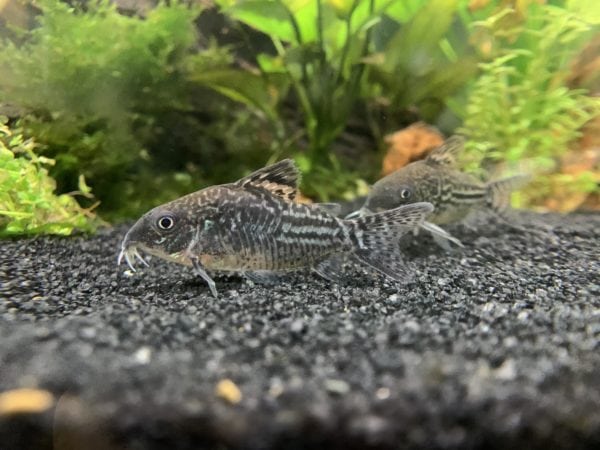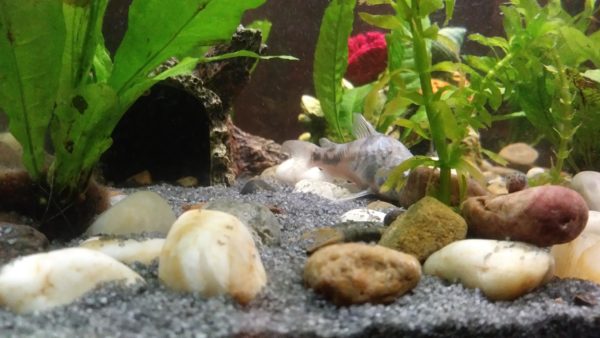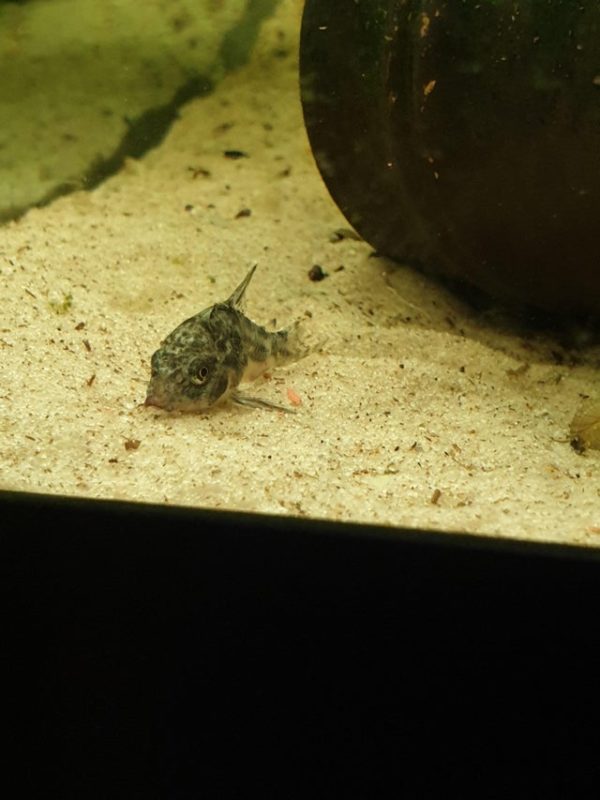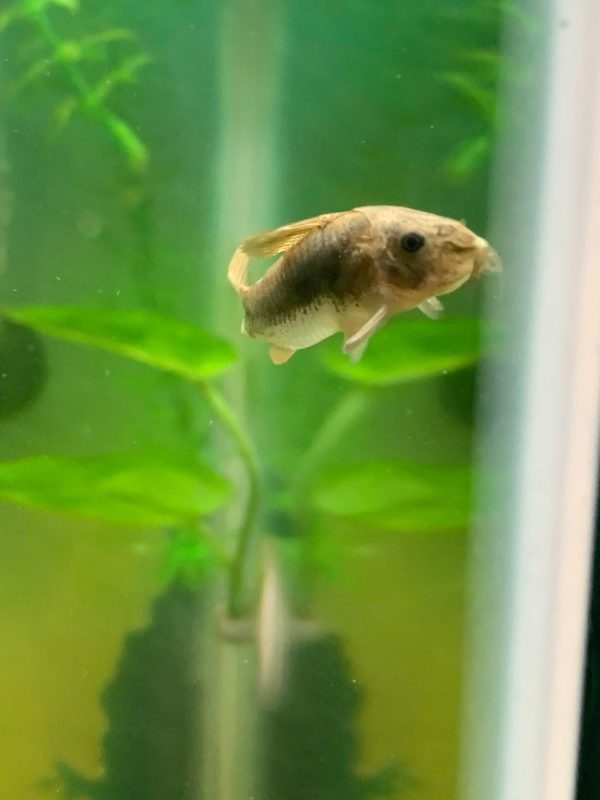Table of Contents
Peppered Cory Overview
Pepper Corys are little, peaceful fish that can assist in keeping your tank’s bottom clean. They’re also entertaining pets with the ability to communicate during courtship. They also “wink” at their owners due to their articulated eyes, which allow them to tilt the eye down and back up without moving the head.
This species, like other Corys, will occasionally dart to the surface of the water and appear to drink air. They can use ambient oxygen; thus, it’s not unusual to observe them do so on occasion. They make a terrific complement to a community freshwater tank when kept in small groups.
Corydoras are fascinating fish that scour your tank for bits and scraps of food. Because they tend to stay at the bottom, you get to fill the middle and upper portions with other fish like tetras, mollies, or even goldfish! While around 3-5 species can be seen in some pet shops, there are actually over a hundred corydoras species, most of them highly hardy, inexpensive, and easy to keep. With that in mind, this article focuses on some of the more popular corydoras species: the Pygmy, Bronze, Panda, and Peppered Cory, comparing and contrasting their looks, behaviors, and required care.
| Information Chart | Peppered Cory |
| Scientific Name: | Corydoras Paleatus |
| Family: | Callichthyidae |
| Care Level: | Easy |
| Temperament: | Peaceful schooling fish |
| Color: | Pale Olive, Dark Green |
| Lifespan: | Five years |
| Size: | 2-3 inches |
| Diet: | Omnivore enjoys live foods |
| Minimum Tank Size: | 15 Gallons |
| Temperature: | 64 – 79 ℉ |
| WaterConditions: | pH 6.0 to 7.0 |
| Tank Mate Compatibility | Compatible with other peaceful species |
Peppered Cory Appearance

With the probable exception of Corydoras Aenus or bronze Cory, Corydoras Paleatus, sometimes known as the Peppered Cory, is the most regularly kept of all Corydoras species. The body of this species is stocky, with two rows of bony plates, commonly known as Scutes, covering it. The scientific term comes from the fact that the head is covered in substantial bone plates. Two pairs of barbels on the upper jaw assist the fish in searching through the substrate for food morsels.
The coloring of the body ranges from pale olive to tan, with an iridescent green shine. The body is covered in a network of dark green-black patterns. No two specimens are alike. The fins are pale, with a dark blotch on the first few rays on the dorsal fin and a sprinkling of tiny dots on the caudal fin. This species bears a spot on the upper tip of its adipose fin. The Albino and a gold variant (commonly referred to as golden Paleatus) are cultivated variations. Most captive-bred animals exhibit less contrast in patterning and less luminosity than wild-caught species.
Types/Varieties of Peppered Cory
Panda Cory: The Bottom-Dwelling Bullet

While pygmies love swimming in the middle section more than the top and bottom parts of the tank, panda corydoras maintain the same energy level as the pygmies, zips, and glances around the bottom of the tank. They’re a bit bigger than pygmies, growing to an average size of 2”. The markings on their bodies – the black stripe that goes over their eyes, the black accents near the tail, and on the dorsal fin, are reminiscent of the markings of the panda, which, as you can guess, is why they’re named panda corydoras. Their behaviors are similar to that of coolie loaches – they tend to swim quickly from corner to corner, shooting up to the surface and back down. If you need a tiny fish that stays at the bottom, the panda cory is a perfect choice, especially for community aquariums housing smaller fish like tetras and dwarf cichlids.
Bronze Cory: The Cookie-Cutter Bottom Dweller

Bronze corydoras are probably the most common corydoras species, being sold in 99% of all pet shops. Featuring a dark black body that quickly tapers to white at the bottom, bronze corydoras flash an iridescent bronze color that sometimes appears green under certain lighting conditions. The albino cory comes from the same species but has a milky, pinkish body with a flash of luminescent silver and a pair of deep crimson eyes. The bronze corydoras you see in pet shops are most likely raised on fish farms because of how easy they are to care for, grow, and breed. For the beginner, the bronze cory is a perfect choice for a bottom dweller. They tend to do better in groups of at least six, so a tank with at least a 20-gallon long footprint is recommended. If you need a scavenger with a track record of hardiness and peacefulness, the bronze cory fits the bill.
Peppered Cory: The Cool Cat

The peppered Cory is the more relaxed catfish in the family. Some aquarists would go so far as to call them sluggish, hovering or perching along the bottom of the tank, then charging for bits of food they spot. Because of this, they don’t get as much love as the other more active Corydoras. The splotches of black scattered across its body make it look more like a crossover between a Dalmatian dog and a bronze cory. The dorsal fin is much shorter than the bronze cory, making it look like a small sail on its back. While this might seem like a minor detail for some, it adds a nice aesthetic touch to a school of peppered cory sailing and cruising along the bottom of the tank. Like the bronze cory, the Peppered Cory also comes with an albino variation, but this variation is quite rare and may command a much higher price. Pepper Corydoras are just as hardy as bronze corydoras and will mix well with placid fish like angelfish. If you need a smooth sailor scavenging along the bottom of your tank, the Peppered Cory is your cat.
The lifespan of Peppered Cory
The typical lifespan of peppered Cory is five years. In comparison to other fish, the Peppered Cory has a lengthy lifespan. Under ideal conditions, the lifespan of a peppered cory can be as long as five years or even longer. However, it is relatively uncommon for Peppered Cory to die immediately after being placed in a tank. This could be related to shipping stress or differences in water parameters between the home tank and store display water. Although Peppered Cory is not as susceptible to this as the more sensitive Otocinclus Catfish, it is worth considering.
Peppered Cory Size
A typical Peppered Cory grows up to two to three inches. The tank conditions define a healthy size. Providing your Cory’s with a suitable environment would be highly beneficial for them. Their diet also characterizes their growth. So remember always to be sure of what they’re feeding on!
Natural Habitat and Origin
Pepper Corys are native to South America, where Charles Darwin originally discovered them during his famous voyages aboard the HMS Beagle in the 1830s. The rivers and streams of the Ro de la Plata Basin, one of the world’s largest river basins, are their home. In Argentina, Brazil, Paraguay, Suriname, and Uruguay, peppers have been discovered in rivers, streams, and tiny lakes. They were one of the first fish to be captive-bred for the aquarium trade, having been raised in captivity for the first time in 1878 in Paris, France.
This fish’s scientific name is derived from the Latin words Cory (helmet), Doras (skin), and Palea (chaff or strips of metal foil), all of which refer to their natural color. Pepper Corys are still one of the most widespread species of Corydoras in the aquarium trade. The majority of retail specimens are captive-bred by commercial breeders in Florida and Asia.
Peppered Cory care and Tank set-up
Peppered Cory Tank size and specifications
Optimum Tank Size for Peppered Cory

The recommended Tank Size for Peppered Cory is 15 gallons. Peppered Corys can be kept in tanks as little as 10 gallons, but it’s better to give them at least a 20-gallon tank to provide them with the greatest possible environment. Because they spend so much time at the bottom of the tank, the bottom’s dimensions are more significant than its height.
They are calm fish that rarely show violence toward one another, even when mating. They can readily coexist with any other peaceful community fish, and they are suitable for most tetras, danios, and even small cichlids.
Tank Shape for Peppered Cory
If you keep the size parameters in mind, the shape of the fish tank doesn’t matter. Circular tanks have less space. Hence, it’s always best to use rectangular or square-shaped tanks. These tanks would provide the fish with adequate space to swim around.
Filter Type
Despite their reputation as robust fish, they nevertheless require a high-quality filter. A hang-on-the-back filter is one of the best filters for a peppered Corydoras tank. These filters are well-known for their endurance, and if properly maintained, they can deliver clean water.
I strongly advise you to utilize an AquaClear Power Filter if you use a hang-on back filter. This filter is exceptionally long-lasting and delivers good filtering even in larger tanks.
Substrate
Gravel or other sharp substrates should be avoided since Peppered Corys constantly root for food in the substrate with their sensitive barbels. Anything sharp in the aquarium might harm their barbels, so choose decorations carefully, and for the substrate, small grain sand is usually the best option.
How many fish in a 15-gallon tank?
Peppered Corys are a schooling fish that should always be kept in groups of five or more. Many aquarists recommend keeping them in groups of 10 or more to properly experience their natural behavior, which will lessen their stress levels and offer you stunning training displays.
Water Parameters for Peppered Cory
Water Temperature
The ideal water temperature for Peppered Cory is 64 – 79 ℉. Perfect water temperatures are essential if you want your fish to grow in a healthy environment. Such a temperature level tries to replicate their natural habitat, which would make them more comfortable. Keeping a routine check of the water temperature would benefit you and your fish in the long run.
pH Level
The perfect water pH level for the Peppered Cory fish is 6.0-7.0. As the fish is sensitive to changes in water composition. It cannot be kept in tanks with varying tank water parameters. They can be susceptible to most tank chemicals, including salt.
Water Hardness
Water Hardness for the Peppered Cory can go up to Up to 12 dGH. Maintaining a perfect hardness level would make sure that your fish is comfortable. A 12 dGH water hardness would be replicating their natural habitat. This would build a conducive environment for them to grow and nurture.
Peppered Cory cannot flourish in tanks with poor water conditions, despite its modest maintenance requirements. Nitrate levels above specific threshold stress and negatively damage the health of these gentle catfish, making them more susceptible to disease.
Avoid shaking up the bottom to ensure that decomposing organic materials do not release bacteria into the tank when cleaning the tank. Nitrite and ammonia levels should also be kept below 0 ppm. Regular partial water changes will help you reduce nitrate buildup and maintain a Cory catfish-friendly tank environment.
Peppered Cory Tank Landscape

This species requires a substrate of either sand or fine smooth-edged pebbles, preferably dark in color, as a bottom dweller who spends their days digging into the substrate. Although live plants are desirable, fake plants can also be employed. To make them feel safe and comfortable, provide plenty of hiding places. Because this species prefers more dim illumination, floating plants are a suitable choice. Driftwood or bogwood can also be used to provide hiding places for this species.
Best Plants for Peppered Cory Tanks
Corydoras prefer foraging plants as well as plants that are large enough to serve as hideaways. A Corydoras isn’t picky about what it enjoys, whether it’s a big shrub or a giant plant with broad leaves, although some live aquatic plants are better suited for the catfish than others. Plants like Echinodorus Tenellus, Cryptocoryne Parva, Lobelia Cardinalis, Vallisneria, Marimo Moss Balls, Blyxa Japonica, Sagittaria Subulata, Micro Sword, Amazon Sword, Java Fern, Neocaridina, etc., will be a perfect addition for their tank.
Worst Plants for Peppered Cory Tanks
It is advisable to avoid plants that cannot survive in the water parameters of a Peppered Cory tank. These plants can die in these water conditions and may even contaminate the water. Other toxic plants that can be hazardous for the aquatic species should be avoided.
Decorations for Peppered Cory Tanks
A biotope modeled after the Amazon would be ideal for this species. With a bit of natural decor like driftwood, bogwood, and leaf litter, as well as a few floating plants, you can create a natural-looking tank in no time.
Lighting for Peppered Cory Tanks
Corydoras enjoys a dark tank with plenty of roots, leaves, and plants. Skittish behavior and dark coloring will occur from a high-energy aquascape with too much lighting; the dimmer your tank, the brighter your fish. Gravel or even some larger Aquascaping surfaces are usually preferable to fine sand because they tend to injure their barrels.
Feeding Peppered Cory
Best Diet for Peppered Cory
Pepper Corys appreciate live foods but can perform well with frozen, flake, granules, and pellet or tablet feeds. Live foods can include bloodworms, brine shrimp, tubifex, and white worms. They are predominantly bottom feeders, and while they will occasionally rise to the top levels in search of food, they eat almost entirely on the bottom.
As a result, make sure that food reaches them. Pellets or tablets that sink are a great approach to ensuring they get their fair amount of the meal. Even though they are active during the day, they frequently feed at night, so drop a few sinking pills in the tank right before turning off the lights to ensure they are adequately provided. Tongs can deliver live food items, which can be stuck around tank decor at the base.
How often should you feed Peppered Cory?
All you have to do is feed your Corys the amount of food they can consume in five minutes. It’s OK to provide them once or twice a day at most. Even when other fishes can’t, they’ll spend the balance of their time scavenging and obtaining food for themselves.
Peppered Cory behavior and temperament
Is Peppered Cory lone or societal in nature?
Under the right circumstances, Peppered Cory can live alone in an aquarium. While a Peppered Cory cat can survive independently, this fish prefers to be in two or more groups. In their hunt for food in the tank, you’ll frequently see two or three Cory cats swimming together and sticking close to one another.
Peppered Cory is among the most gregarious small fish species, and while they may survive on their own, they are frequently happiest in groups because they prefer schooling. Two or three Peppered Cory of the same species can often cling together inside the tank, moving in perfect synchronicity.
They’ll be happier if you have more Peppered Cory in the tank. These bottom-dwellers prefer to scavenge and feed in groups, which explains why they’re mainly connected with social behavior. Although Peppered Cory gets along with most non-predator fish, they prefer to keep with their own species.

Peppered Cory Tankmates
Ideal Peppered Cory Tankmates
This species is best kept in groups of three or more in modest to large aquariums. Other little fish, such as small peaceful Darbs, Danios, Livebearers, Killifish, Small Tetras, and Dwarf Cichlids, make excellent tankmates. Keep in mind that this species likes colder water, so don’t mix it with tropical species that demand warmer temps. Also, avoid putting them in the same tank as large or aggressive fish.
The pepper cory has razor-sharp barbs under each eye, below the adipose fin, and in front of the dorsal fin, just like the other members of this family. They’re designed to keep bigger fish from eating them. These, however, might cause complications when attempting to net this small catfish, so caution is advised. This species is generally calm, and despite being very busy during the day, they are also noted for staying in one position for lengthy periods, scouring the surroundings for food scraps. They prefer to be in the company of their kind and thrive in shoals.
The ability of this species’ pectoral fins to make sound by abduction (movement away from the midline of the body) is an intriguing trait. This behavior is most commonly observed during courtship or in socially anxious juveniles.
Bad Tankmates for Peppered Cory
Cichlids and aquarium crayfish should not be housed with cory cats. Oscars, Texas Cichlids, and Jack Dempsey are all roughens that can harm or even devour Peppered Cory. These species can be threatening for the Peppered Cory.
Breeding Peppered Cory
It’s best to choose a breeding pair or a trio with two males and one female. To assure success, some breeders prefer an even higher male to female ratio. Small live meals like bloodworms, brine shrimp, daphnia, and tubifex should be fed to the breeders to condition them. These fish are egg layers, meaning they will consume their eggs, necessitating a separate tank for spawning and raising the fry.
When the female is ready to spawn, her girth will noticeably rise, and the fish will generally become more active. The female’s belly and the first ray of the pectoral fin may be reddish. Perform a significant water change (about 25%) with water that is colder than the temperature in the tank at this stage. The goal is to lower the water temperature by around five degrees to simulate the rainy season, which will lead to spawning.
The male swims across the female’s back in the early stages of spawning, near enough for his barbels to touch her back. During the spawning ritual, males are frequently seen shivering. The male will eventually assume the conventional “T” position, with his torso at a right angle to the female’s nose.
The discharge of sperm and one to ten eggs, which the female will clutch between her cupped pelvic fins, is triggered by this position. The pair separates once the eggs have been fertilized. The female puts the sticky eggs on a surface she has already picked and cleansed for the purpose. This might happen on the glass, in the filter tubes, or on the plant leaves.
Once the eggs have been laid, the males will pursue the female once more, and the mating ritual will begin. This process is done until 200 to 300 eggs have been fertilized and deposited in the tank. Spawning can last an hour or longer. Adults should be removed from the tank once spawning is complete. The eggs will hatch in four to six days. This can vary depending on the water temperature. The time it takes for eggs to hatch can be extended by up to two days in colder water.
The fry can be fed minimal foods like Cyclops, freshly hatched Brine Shrimp, Micro Worms, or commercially prepared fry diets once the eggs have hatched. Maintain good water quality by changing the water frequently.
Peppered Cory Breeding Level- Easy
Peppered Cory Sexual Dimorphism
To distinguish between male and female Peppered Cory, we should look at their overall appearance. Females get noticeably more prominent and more rounded, primarily when inbreeding occurs.
Peppered Cory common diseases and their treatment
Infections from bacteria

Take note of their lack of movement, fading colors, swollen bodies, ragged fins, and hazy eyes. Open sores, crimson streaks, and protruding eyes are all possible symptoms. Others experience skin and internal organ irritation, as well as respiratory difficulties.
Infections from Fungi
They have a habit of darting around, swimming wildly, and clawing when they are agitated. Cotton-like tufts appear on the skin, eyes, and mouth of certain people.
Infections from parasites
Three clear indicators are their lack of movement, appetite loss, and abundant mucus on their film and body. Other signs and symptoms include difficulty breathing, excessive itching, and visible patches or worms.
If you notice that your Peppered Cory has bulging eyes and swollen heads, Corneybacteriosis could be the reason. Antibiotics such as tetracycline and penicillin, which are available over-the-counter, can be used to treat them.
Ragged or decaying fins Finrot could be the root of the problem. First, check the pH of the water in the tank. If everything appears to be expected, treat your fish with over-the-counter antibiotics for their fins or tails. Remember to keep the tank water clean regularly.
Facts about Peppered Cory
- Brazil, Uruguay, Paraguay, and Argentina are all home to this species. It lives in shallow, clean bodies of water.
- Females get noticeably more prominent and more rounded, especially when inbreeding occurs.
- Pepper Corys have been bred in captivity for nearly a century and are the first to maintain pets. There is also a long-finned variant and an albino type in addition to the ordinary kind.
FAQ
Which family does Peppered Cory come from?
Corydoras belong to the family of armored catfish.
What is the Genus name of the Peppered Cory?
The genus name means “helmet skin,” The fish are tough, tiny fish that live up to their moniker.
What is the minimum Tank Size for Peppered Cory?
The recommended Tank Size for Peppered Cory is 15 gallons.
Conclusion
With over a hundred species and counting, corydoras never ceases to surprise the fishkeeping community with new splashes of color, unique shoaling behavior, and excellent scavenging skills. With breeders continually searching for new strains and varieties, new ones are bound to pop up at least every decade. We talked about the four classic corydoras: the pygmy, panda, bronze, and peppered Cory. While new strains and species come up every so often, these four classics have consistently won the hearts of many aquarists, both beginner and advanced. Before venturing off to find unique and expensive new fish species to add to your tank, you might want to consider these four classics.
No related posts.
